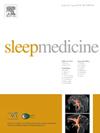Regional cerebral blood perfusion impairment in type 1 narcolepsy patients: An arterial spin labeling study
IF 3.8
2区 医学
Q1 CLINICAL NEUROLOGY
引用次数: 0
Abstract
Objective
To investigate the pathophysiological characteristics of cerebral blood flow (CBF) in patients with narcolepsy type 1 (NT1) via the arterial spin labeling (ASL) technique.
Methods
Thirty patients with diagnostic NT1 (PTs) and 34 age- and sex-matched healthy controls (HCs) were recruited for this study. Basic information was collected, and clinical evaluation and neuroimaging, including ASL and T1-3DBRAVO, was performed. The z-normalized CBF (zCBF) and spatial coefficient of variation (sCoV) were calculated, and the changes in NT1 were compared via analysis of covariate (ANCOVA). Furthermore, spearman's correlation analysis between impaired regional perfusion and clinical features was performed. Age, sex, and normalized grey matter volume were included as covariates.
Results
Compared with that of HCs, the zCBF of PTs significantly differed in regions of fronto-temporal-occipital cortex, right insula and posterior insula, and left rostral/dorsal anterior cingulate gyrus (ACG) (P < 0.006). Moreover, the sCoV was significantly altered in the frontotemporal cortex, rostral ACG, right hippocampus, and posterior insula (P < 0.003). In PTs, positive correlations were identified between the zCBF of the right superior/middle frontal gyrus (SFG/MFG) and mean sleep latency, and between the zCBF of the left SFG of the frontal pole and sleep hallucination severity. Moreover, the sCoV of the right MFG/hippocampus were positively associated with Rapid Eye Movement efficiency and negatively associated with Hamilton Anxiety Scale score, respectively.
Conclusion
PTs exhibited abnormal regional perfusion in the frontal-temporal-occipital cortex and limbic system regions, which may serve as patient-specific imaging markers. Alterations in perfusion may lead to the clinical manifestations of underlying psychological and sleep disorders in PTs.
1型发作性睡病患者局部脑血流灌注损伤:一项动脉自旋标记研究
目的应用动脉自旋标记(ASL)技术探讨1型发作性睡(NT1)患者脑血流量(CBF)的病理生理特征。方法本研究招募了30例诊断性NT1 (PTs)患者和34例年龄和性别匹配的健康对照(hc)。收集基本资料,进行临床评价和神经影像学检查,包括ASL和T1-3DBRAVO。计算z归一化CBF (zCBF)和空间变异系数(sCoV),并通过协变量分析(ANCOVA)比较NT1的变化。并对局部灌注损伤与临床特征进行spearman相关分析。协变量包括年龄、性别和规范化灰质体积。结果与正常人相比,PTs的zCBF在额颞枕皮质、右岛、后岛、左扣带回喙侧/背侧前回(ACG)区域差异有统计学意义(P <;0.006)。此外,额颞叶皮层、吻侧ACG、右海马和后岛的sCoV显著改变(P <;0.003)。在PTs中,右额上回/中额回的zCBF与平均睡眠潜伏期呈正相关,额极左额上回的zCBF与睡眠幻觉严重程度呈正相关。此外,右侧MFG/海马的sCoV分别与快速眼动效率呈正相关,与汉密尔顿焦虑量表评分负相关。结论pts在额-颞-枕皮质和边缘系统区域表现出异常的区域灌注,可作为患者特异性的影像学标记。灌注改变可能导致PTs潜在心理和睡眠障碍的临床表现。
本文章由计算机程序翻译,如有差异,请以英文原文为准。
求助全文
约1分钟内获得全文
求助全文
来源期刊

Sleep medicine
医学-临床神经学
CiteScore
8.40
自引率
6.20%
发文量
1060
审稿时长
49 days
期刊介绍:
Sleep Medicine aims to be a journal no one involved in clinical sleep medicine can do without.
A journal primarily focussing on the human aspects of sleep, integrating the various disciplines that are involved in sleep medicine: neurology, clinical neurophysiology, internal medicine (particularly pulmonology and cardiology), psychology, psychiatry, sleep technology, pediatrics, neurosurgery, otorhinolaryngology, and dentistry.
The journal publishes the following types of articles: Reviews (also intended as a way to bridge the gap between basic sleep research and clinical relevance); Original Research Articles; Full-length articles; Brief communications; Controversies; Case reports; Letters to the Editor; Journal search and commentaries; Book reviews; Meeting announcements; Listing of relevant organisations plus web sites.
 求助内容:
求助内容: 应助结果提醒方式:
应助结果提醒方式:


